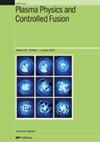The effect of divertor particle sources on scrape-off-layer turbulence
IF 2.3
2区 物理与天体物理
Q2 PHYSICS, FLUIDS & PLASMAS
引用次数: 0
Abstract
Tokamak edge turbulence is crucial for the cross-field transport of particles and energy away from the separatrix. A better understanding of what affects the turbulence helps to control the heat flux to the divertor targets and the wall. One potentially important factor is the ion particle source in the divertor, as the neutral pathways and the ionisation source distributions are different depending on the divertor geometry, e.g. vertical- and horizontal-target configurations. Numerically, how to represent the sources and mimic the effects on the SOL in the simulations is still an open question. In this paper, we use a 3D turbulence code STORM, based on drift-reduced Braginskii equations, to study the effects of the divertor particle source distribution on turbulence in a simplified 3D slab geometry. The results show that it requires a large amount of divertor particle source to be peaked near the separatrix to alter the heat flux deposited on the target in attached conditions. This large non-uniform particle source can locally enhance the turbulence in the divertor volume, which redistributes the energy flux to the target and reduces the maximum amplitude. Meanwhile, the plasma profiles evaluated at the outboard midplane, such as the amplitudes and fluctuations of the density and temperature, are marginally changed. Another consequence of our results is that the prediction of the temperature difference between the outboard midplane and the target would be underestimated, if the calculation only considers the conductive heat flux and ignores this enhanced cross-field transport in the divertor.分流粒子源对刮离层湍流的影响
托卡马克边缘湍流对于粒子和能量离开分离矩阵的跨场传输至关重要。更好地了解湍流的影响因素有助于控制流向分流器目标和壁面的热通量。一个潜在的重要因素是分流器中的离子粒子源,因为中性路径和电离源分布因分流器的几何形状(如垂直和水平靶配置)而异。从数值上讲,如何在模拟中表示电离源并模拟其对 SOL 的影响仍是一个未决问题。在本文中,我们使用基于漂移还原布拉金斯基方程的三维湍流代码 STORM,研究了分流器粒子源分布对简化三维板状几何中湍流的影响。结果表明,要改变附着条件下沉积在目标上的热通量,需要大量的分流粒子源在分离矩阵附近达到峰值。这种大量的非均匀粒子源可以局部增强分流器体积内的湍流,从而重新分配目标上的能量通量并减小最大振幅。同时,在外侧中平面评估的等离子体剖面,如密度和温度的振幅和波动,变化不大。我们研究结果的另一个结果是,如果计算时只考虑传导热通量而忽略了分流器中增强的跨场传输,那么外侧中平面与目标之间的温差预测值就会被低估。
本文章由计算机程序翻译,如有差异,请以英文原文为准。
求助全文
约1分钟内获得全文
求助全文
来源期刊

Plasma Physics and Controlled Fusion
物理-物理:核物理
CiteScore
4.50
自引率
13.60%
发文量
224
审稿时长
4.5 months
期刊介绍:
Plasma Physics and Controlled Fusion covers all aspects of the physics of hot, highly ionised plasmas. This includes results of current experimental and theoretical research on all aspects of the physics of high-temperature plasmas and of controlled nuclear fusion, including the basic phenomena in highly-ionised gases in the laboratory, in the ionosphere and in space, in magnetic-confinement and inertial-confinement fusion as well as related diagnostic methods.
Papers with a technological emphasis, for example in such topics as plasma control, fusion technology and diagnostics, are welcomed when the plasma physics is an integral part of the paper or when the technology is unique to plasma applications or new to the field of plasma physics. Papers on dusty plasma physics are welcome when there is a clear relevance to fusion.
 求助内容:
求助内容: 应助结果提醒方式:
应助结果提醒方式:


